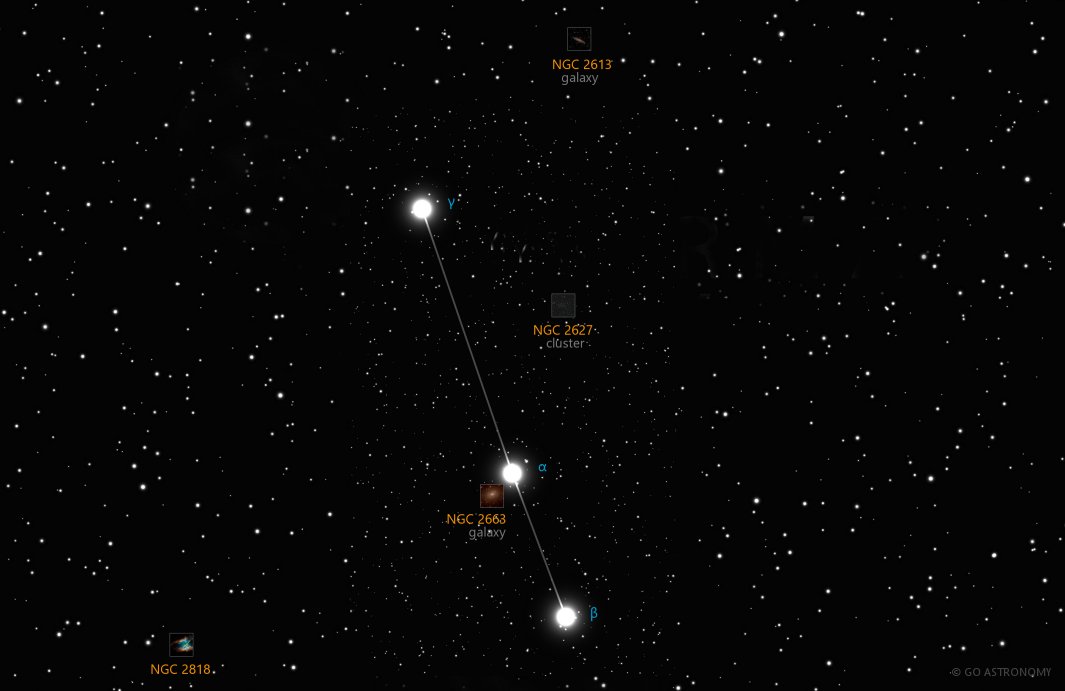Pyxis, the Compass (Pyx)
(PIX-iss)
The Southern constellation of Pyxis, the Compass, is best viewed in Spring during the month of March.
Pyxis is the 65th largest constellation. It's brightest star is Alpha Pyxidis at magnitude 3.68. The boundary of the Pyxis constellation contains 4 stars that host known exoplanets.
- Pronunciation:
- PIX-iss
- Meaning:
- Compass
- Genitive:
- Pyxidis
- Abbreviation:
- Pyx
- Constellation Family:
- Heavenly Waters
- Hemisphere:
- Southern
- Quadrant:
- SQ2
- Visibility:
- 50° N - 90° S
- Best viewing month*:
- March
- Area:
- 221 sq. degrees
- Size:
- 65th largest
- Right Ascension (avg):
- 8h 53m
- Declination (avg):
- -29°
- Brightest star:
- Alpha Pyxidis (3.68)
- Stars with planets:
- 4
- Messier objects:
- |
- Caldwell objects:
- |
Brightest Stars in Pyxis
The 10 brightest stars in the constellation Pyxis by magnitude.
- Star
- Magnitude
- Spectral class
- Alpha Pyxidis (α Pyx)
- 3.68
- B1.5III
- Beta Pyxidis (β Pyx)
- 3.97
- G5II/III
- Gamma Pyxidis (γ Pyx)
- 4.02
- K3III
- Kappa Pyxidis (κ Pyx)
- 4.62
- K4/K5III
- Theta Pyxidis (θ Pyx)
- 4.71
- M0III
- Lambda Pyxidis (λ Pyx)
- 4.71
- G8III
- Zeta Pyxidis (ζ Pyx)
- 4.86
- G5III
- Delta Pyxidis (δ Pyx)
- 4.87
- A3IV
- HD 73752
- 5.05
- G3/G5V
- HD 75605
- 5.19
- G8III
Star Clusters in Pyxis
The most notable and easy-to-find star clusters in the constellation Pyxis . Also see all star clusters.
Galaxies in Pyxis
The most notable galaxies in the constellation Pyxis. Also see all galaxies.
The Celestial Mariner's Compass
Located in the Southern sky, the constellation Pyxis is a small but noteworthy constellation. Representing the Mariner's Compass, Pyxis has a rich maritime history and a variety of interesting stellar bodies.
Historical Background
The constellation Pyxis was not among the original 48 constellations defined by Ptolemy in the 2nd century. It was introduced in the 18th century by French astronomer Nicolas Louis de Lacaille, who named it "Pixis Nautica," but the name was later shortened to Pyxis. Lacaille is known for dividing the large constellation Argo Navis into three smaller ones, but Pyxis was not part of this division. Instead, it represents the compass that would have guided the mythological ship.
Location and Visibility
Pyxis lies in the second quadrant of the southern hemisphere (SQ2) and is visible between latitudes +50? and -90?. The constellation spans an area of about 221 square degrees, making it the 65th largest constellation in the sky. Pyxis is bordered by the constellations Antlia, Hydra, Puppis, and Vela. The best time to observe Pyxis is during the month of March.
Main Stars in Pyxis
The constellation Pyxis is made up of several stars, the brightest of which is Alpha Pyxidis, a blue-white giant star located about 880 light-years away from us. The second brightest star, Beta Pyxidis, is a yellow giant star about 420 light-years away. The constellation also includes Gamma Pyxidis, a red giant that is nearly 207 light-years distant from our solar system.
Deep Sky Objects
Despite its small size, Pyxis contains several intriguing deep sky objects. The constellation is home to several galaxies including the spiral galaxy NGC 2613, which is located approximately 60 million light-years away. Other noteworthy objects in Pyxis include the planetary nebula NGC 2818, which lies within an open star cluster. This unique pairing offers a captivating sight for astronomers.
Observation
Observing Pyxis can be an exciting venture, especially for those situated in the Southern hemisphere. The constellation's stars are not particularly bright, so a clear night and an area far from city lights will provide the best viewing conditions. To locate Pyxis, one can first identify the bright star Canopus in the constellation Carina and then move in the direction of Sirius; Pyxis will appear along that imaginary line. Telescopic observation of Pyxis can reveal its deep-sky objects, including the distant galaxies and the beautiful nebula NGC 2818.
* Constellation shown for northen hemisphere skies. For the southern hemisphere, constellations appear rotated 180 degrees (upside-down and left-right reversed) from what is shown. Remember that seasons are reversed too - summer in northern latitudes is winter in southern latitudes.
** Circumpolar constellations are visible year-round in the hemisphere listed (and not at all in the opposite hemisphere).





